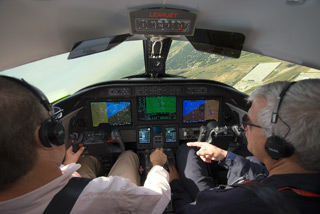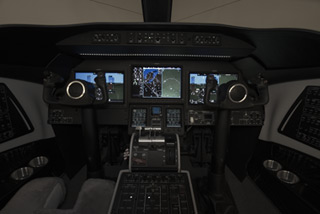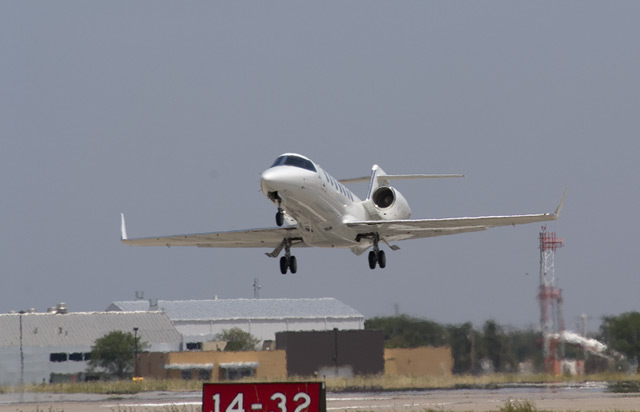Following its acquisition of Learjet, Bombardier's first new offering in the super-light segment was the Learjet 45. Certificated in 1997, the 45 is larger than the legacy 31A and smaller than the 60. When production of the light 31A was discontinued in 2003 the 40, a straightforward shrink of the 45, was introduced to fill the gap. Both the Learjet 40 and 45 - to include their heavier and longer-range XR variants - have performed well in the marketplace, with a combined total of 563 types produced up to April 2012. The competitive market, however, has kept moving on. Perhaps the most notable new entry into the super-light segment is Embraer's Phenom 300, which received US Federal Aviation Administration certification in December 2009
 |
DA Russell Bombardier’s Learjet 70/75 was announced at EBACE 2012 |
When I flew the Phenom 300 in 2010, I was impressed by its Garmin G1000-based "Prodigy" avionics suite. Embraer billed the Prodigy suite - featuring three 31cm (12in) Garmin displays - as a G1000 suite on steroids. Having flown several aircraft with a basic G1000 set-up, I felt the Phenom's suite had indeed raised the bar.
Sensing the need to freshen its own offerings in the light/super-light segment, Bombardier launched the Learjet 70/75 this year to replace its 40/45 product line. Conceived as a joint effort with Garmin, the 70/75 would incorporate Learjet's new Vision Flight Deck (VFD) along with aerodynamic and propulsion enhancements. Bombardier would take the lead on the airframe, interior and engines, with Garmin responsible for the extensive changes envisioned for the avionics suite.
Launched in 2007, the composite fuselage Learjet 85 took the brand into the mid- to super-midsize segment. The Learjet 70/75's interior will incorporate many design elements of the 85. The 70 will seat six in a club forward configuration, while the larger 75 will seat eight in a double-club arrangement. As with the 85, the 70/75 will have a Lufthansa Technik "niceR" cabin-management and in-flight entertainment system, which features 17.8cm touchscreen monitors at most seats and a forward bulkhead-mounted 31cm monitor. The ethernet-based system allows for much flexibility, with optional in-flight broadband connectivity.
AIRFRAMER'S VISION
Bombardier also introduced its VFD on the Learjet 85, and is designed to maximise productivity, safety and convenience across all product lines. For the Global 6000, the VFD is built around a Rockwell Collins Pro Line Fusion avionics suite with four 38cm LCD displays and a head-up guidance system (HGS). The VFD for the 85 is a Pro Line Fusion-based system with three 38cm displays and no HGS. Garmin was selected to supply the VFD for the 70/75. Improvements to the 40/45 are not limited to flightdeck and cabin. The 40/45 had Honeywell TFE731-20-BR engines, which produced 3,500lb (16kN) of thrust. The 70/75 features a "-40-BR" version of the same engine with an installed thrust of 3,850lb. Compared with the 40, the 70 has improved take-off performance. At maximum take-off weight (MTOW) and standard day conditions it has a 17m (56ft) shorter take-off distance.
 |
| DA Russell |
Compared with the heavier XR version, the improvements are even more dramatic. The 40XR had an MTOW almost 300kg higher and take-off distance had increased to 1,426m. Higher-thrust engines on the 70, which has the same MTOW as the 40XR, give it a take-off distance of 1,306m, nearly as short as the original 40. Under hot and high conditions, the improvement is more dramatic. Bombardier says the 70/75 is expected to offer up to a 9% reduction in required take-off distance compared with its 40XR/45XR predecessors.
Maximum range for the new models has also been improved. Bombardier is projecting a 4% reduction in fuel burn. This marked decrease is driven by two factors: reduced weight and improved winglet aerodynamics. The Garmin-supplied avionics suite weighs about 200lb (90kg) less than the old Honeywell Primus system. While the new winglet is roughly the same as the legacy one, it is mounted less vertically relative to the wing, measurably reducing drag. These improvements give the 70 nearly 188km (100nm) more range than the 40XR.
While the 70/75 was only publicly announced at the 2012 EBACE convention, developmental flights have already been taking place, with five flight-test aircraft slated for the effort. FTV1 and FTV2 (a 45 and 40 respectively), are avionics aircraft modified and operated at Garmin's New Century airfield in eastern Kansas. The modified 45 first flew in August 2011, followed by the modified 40 in February 2012. Since then, the avionics test aircraft have flown 135 flights and 230h. FTV3 will be used for interior and cabin management system development. The improved winglet design and enhanced engines will be developed with FTV4, and FTV5 will be the first production representative aircraft. Bombardier will operate the latter three FTVs. While only the avionics aircraft have flown, Bombardier has set an initial entry-into-service date in the first half of 2013 for the 70 and 75.
MODIFIED 40XR
My preview aircraft was FTV2, a modified 40XR with US registration N785BC. It had all the hardware of the proposed VFD, but lacked some of the aesthetic touches promised for the production aircraft. Additionally, the cabin was configured for flight test and lacked the Learjet's normal plush fittings and seats. Finally, it lacked the modified winglet and higher-thrust engine slated for the 70, limiting our flight to a preview of the VFD.
Prior to boarding, I spent time in the 75 cockpit mock-up seen at recent trade shows. The flightdeck of the legacy 40 reminded me of that of the Boeing 737-300. It was a round-dial design with modern glass grafted in - utile but not polished. The transformation to flightdeck from the 40 I had flown eight years ago - as seen in both the mock-up and preview aircraft - was amazing. Four 200mm x 180mm CRTs have been replaced by three large Garmin GDU1400 wide-format LCD displays. With a diagonal measure of 356mm they provide twice the viewable area as the Primus CRTs. Three round-dial standby instruments have been replaced by a single L3-sourced electronic standby instrument system. Underneath the glareshield a single GMC 7250 Flight Guidance Panel (FGP) is flanked by two back-up control units. The large pedestal-mounted FMS unit is no longer required; pilot interface with the G5000 suite is via two GTC570 touchscreen units mounted at the base of the instrument panel/head of the centre pedestal.
 |
DA Russell The G5000's autopilot is Garmin's most powerful |
Most systems-control panels have been moved from the base of the instrument panel to the centre pedestal aft of the throttle quadrant. Toggle switches on the panels are now predominately backlit push buttons. The total result is a sleek modern flightdeck that appears to be on par with those offered in several large-cabin business jets.
Lead Garmin flight-test pilot Tom Schaffstall accompanied me on the flight. Once on board, aircraft specific pre-start procedures were carried out with reference to the standard electronic checklist (ECL). The current ECL is not a smart one with automated item "check off", but Garmin and Bombardier are exploring offering such a feature in the future.
One enhancement the G5000 suite brings to aircraft pre-flight procedures is deletion of the rotary test knob. Required system tests are now initiated via the GTC570 control display unit (CDU) and sequentially accomplished, providing a minor but welcome workload reduction. The G5000 can store canned flightplans, but our round-robin flight from Wichita's Mid-Continent airport was entered manually through the CDU. For longer or more complicated flights, an SD card can be used to load the flightplan.
The CDU is divided into three sections: a radio bar at the top, a large desktop in the middle, and a virtual button bar at the bottom. Additionally, on the base of the bezel are three physical function knobs: cursor control, volume and frequency tuning. I found the last two particularly useful, as at times I prefer twisting a knob to punching in numbers.
The GTC570's 14.5cm touchscreen display uses infrared position sensors to determine the virtual button push location. The system will not execute a "push" if the pilot's finger leaves the display field in a different location from where it entered. Audible feedback is selectable, with a "clunk" announcing an unexecuted push. The push location logic and audible feedback capability of the display should prove to be very useful in turbulent flight conditions.
The G5000 system was used to calculate and display runway performance data for our take-off conditions. The avionics suite comes as standard with Garmin's SafeTaxi, which showed aircraft position in real-time on a Garmin-devised airfield graphic. During the brief taxi from the staging area at Bombardier's Wichita facility to RWY19R, I was able to chart our progress on the centre multifunction display. This feature will enhance positional awareness while reducing the likelihood of a runway incursion.
Once cleared for take-off, the lightly loaded Learjet rapidly accelerated down the runway. With the gear and flaps retracted I used the "V" bar flight director to guide the climb out. At medium altitude we preceded to the west of KICT to evaluate the VFD. Fairly early in the climb I engaged the autopilot and used the FGP to control the aircraft. The autopilot in the G5000 suite is Garmin's most powerful and operates in all three control axes. It incorporates a yaw damper (YD), which was engaged for all operations away from the traffic pattern. At airspeeds below an indicated airspeed of 250kt, the YD effectively damped out any Dutch Roll motion induced by rapid rudder pedal inputs.
EASY READING
I found the large primary flight display (PFD) easy to read and interpret, even in direct sunlight. The large display area allotted to the PFD is well used. The attitude direction indicator's horizon line spans the entire display. The large altitude and airspeed tape scales were sharp and easy to read. I especially like the airspeed trend arrow, which facilitated accurate manual airspeed control. The large PFD also provides a large palette for the VFD's standard synthetic vision system. While central Kansas is flat, synthetic vision terrain depictions could be useful during approaches in low-visibility conditions.
TCAS II-derived targets were displayed in a "God's eye" view format in an insert box on the PFD. When a TCAS target is within the ADI's field of view, it is also presented on it at the correct relative azimuth and elevation. This feature should help the pilot visually acquire conflicting aircraft. Kansas summer weather is frequently punctuated by afternoon thunderstorms, but the standard G5000 avionics suite has a very capable Garmin GWX 70 digital weather radar. Optional ground clutter suppression and turbulence-detection modes further enhance weather detection and avoidance. For an even bigger picture, the optional Garmin GDL 69 datalink receiver can pipe XM satellite weather on to the flightdeck. As luck would have it, the morning preview flight was concluded before any thunderstorms formed, limiting my evaluation of these two promising systems.
With time running short on the one-hour scheduled flight, we accepted ATC vectors for our return to Wichita Mid-Continent airport. Schaffstall watched as I loaded the RNAV GPS Y 19R approach. The standard Garmin ChartView software allows the VFD to be paperless, reducing pilot workload while preventing untold numbers of paper cuts. For the approach, we selected the LPV (localiser precision with vertical guidance) minimums, typically the lowest available for a GPS approach.
From the pilot's perspective, flying a RNAV approach to LPV minima is nearly identical to executing an ILS. The 40 is a stable instrument platform, and with the AP engaged on final all I needed to do was track the target airspeed with the thrust levers. At minimums I shifted my scan outside and accomplished the landing. During the visual portion of the approach I could not fail to notice the synthetic runway depiction on the PFD rise to meet us as we touched down in the real world.
 |
DA Russell The morning preview flight was concluded before any storms formed |
The Vision Flight Deck I flew on the modified 40 is an extremely capable one with seemingly limitless flexibility. The large display area is well used with critical flight information readily available.
Prior to the flight I had been wary of CDU's touchscreen display lacking tactile feedback, but once airborne I found audio and visual cues allowed for effective in-flight button pushes. The joystick CCD mounted on the bezel of the CDU allowed me to manipulate the displays and enter data in a fairly intuitive manner, but I would have preferred a trackball.
My preview flights have allowed me to evaluate many different flightdecks, each manufacturer having their own signature traits. My brief encounter with the Learjet's Garmin G5000-based Vision Flight Deck showed it to be the most capable one I have seen in a light business jet. Dassault's EASy is still my hands-down favourite flightdeck, but the Vision Flight Deck is not far behind, with a much lower cost.
Source: Flight International



















